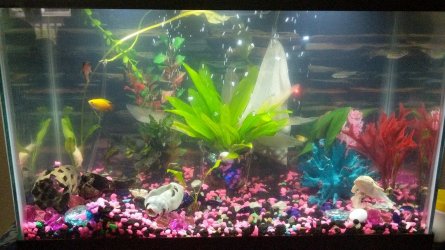Greetings.
Please hold fire on adding any chemicals to the tank, until you know for certain what is causing the issue.
It would help to know your tank details, (history, stocking, contents, etc), and your water chemistry.
Who would've thought that when you started sticking fish in a glass box, you'd need all this biochemistry?

Thanks for the reply!
Was kinda waiting for type of response I got before offloading all the gory details, cause this one's a doozy... baffling just about everyone I've asked for advice so far...
So, it's a 10 gal freshwater tank that had been established for about a year or so when I crashed the biofilter by taking out a large decoration (which had a BBA infestation) and changing all the filer media at once. Charcoal cartridge, sponge and did a water change. Ever since I've been struggling with NH4 and trying to get the tank cycled again. What I've learned is that I should also have been monitoring pH. When I finally started testing pH (after 7 months of head scratching) it was very low ~ 5.5-6. Cue me trying to fix the pH and spiking the ammonia of course...
As of Monday, when I went to the LFS for advice, I had them do a spectrometer test to make sure my API kit wasn't flawed and the H2O tested 7.4 pH, 4 KH and a whopping 3.2ppm NH4. I immediately did a 50% water change and tested again 12 hours later. The pH was 6.8 and NH4 was at .5ppm. I did another 30% change. Please bear in mind I am dosing with Prime and Seed with every water change. 8 hours later I tested again and the pH was <6 and the KH was 1, while the NH4 was at .25. I added a teaspoon of baking soda as a quick fix to raise the pH and KH to 7.6 and 7 respectively.
Testing this morning said the ammonia was holding steady, but the pH had dropped to 7 and the KH to 5. Tap water is all normal at 7.4, 5 and zero for pH, KH and NH4. I tested my established 3 gal as a control and everything is perfect across the board.
I currently have 2 honey gouramis, 2 plain corys and 3 scissortail rasporas, but that is after losing some stock throughout this process. My feeding schedule is an 1/8th teaspoon every two days. I also have four larger live plants and some moneywort in the tank as well which I use Flourish tabs to keep fed.
Hope this is enough for a start, like I said, I have all the staff at my LFS grasping at straws at the moment, but the KH data is new, so we'll see what they say when I go back on Monday. Thier current theory is my gravel may be leeching NH4...

Thanks for any advice and help you can muster!
Richard

